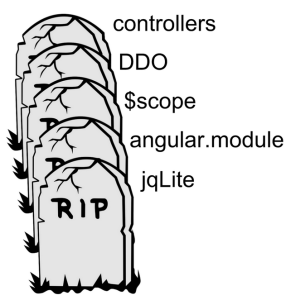Here at Oasis Digital, we have been excited about the possibilities for Angular 2.0 ever since its (somewhat contentious) public debut at the Fall 2014 European Angular conference.  That was the conference with the infamous “tombstone” slides, and the frequently misunderstood explanation by the Angular team members that they did not have a migration strategy for Angular 1-to-2 yet. Many commenters at the time seemed to misunderstand the yet part as some assertion that there would be no migration strategy at all. Fortunately, the agitation around that initial announcement has subdued, work has continued, progress is being made.
That was the conference with the infamous “tombstone” slides, and the frequently misunderstood explanation by the Angular team members that they did not have a migration strategy for Angular 1-to-2 yet. Many commenters at the time seemed to misunderstand the yet part as some assertion that there would be no migration strategy at all. Fortunately, the agitation around that initial announcement has subdued, work has continued, progress is being made.
 Though there has been quite a lot of progress on Angular 2, which we have been following (much of the development is being conducted in the open) our recommendation now is that if you don’t have a reason to work with A2 well before its release, you’re probably better off ignoring it a bit longer. As I write this in August 2015, the Angular 2 alpha versions are still rather rough, particularly in the experience of getting started.
Though there has been quite a lot of progress on Angular 2, which we have been following (much of the development is being conducted in the open) our recommendation now is that if you don’t have a reason to work with A2 well before its release, you’re probably better off ignoring it a bit longer. As I write this in August 2015, the Angular 2 alpha versions are still rather rough, particularly in the experience of getting started.
But at Oasis Digital we do have a compelling reason to start using new versions before they are ready. We must do this so that we have significant experience when the time comes to start teaching our students (for our Angular class) how to use the new version, and even for the teaching we already include in the class about how to prepare for Angular 2.
One of our primary trainers, Paul Spears, has been leading the charge. Here are links to a couple of repositories he has published, showing a minimal project to get up and running with Angular 2, loaded using JSPM:
- https://github.com/dpsthree/NG2-TS-JSPM (TypeScript)
- https://github.com/dpsthree/NG2-ES5-JSPM (plain ES5/JavaScript)
There is quite a lot to explain about what is going on in those repositories, here are a few of the most important bits.
We expect that many teams (perhaps most) will concurrently upgrade their development/build tools to the current generation of ES6/2015 module-centric build systems. The leader in the space appears to be JSPM, so we have chosen that for this work. It is also possible (and we will likely publish example this way in the future) to simply load Angular 2 along with its required dependencies using the script tags from downloaded files or from a CDN, of course.
The JSPM configuration may look quite alien compared to the familiarities of Grunt or Gulp. This is because of the above-mentioned module loader approach, and because JSPM already understands many things that must be explained to Grunt or Gulp by the user or a plugin.
These examples are set up for development, loading numerous separate tiny libraries using numerous HTTP requests; but JSPM and similar tools also have an excellent solution for production asset preparation, using essentially the same configuration information to package all of the JavaScript into a file or two.
These repositories show working examples as of right now, early August 2015. Angular 2 has been changing quite substantially from one alpha to the next. Moving up to the next version will likely require adjustments, as it has in previous versions. This is definitely alpha software.
The config.js file looks quite scary, but much of the contents there are generated by JSPM tooling. With some adjustment, it is possible to omit the hairiest block of information therein from source control, and instead treat it as a build artifact. As you look at the contents of that file, remember that you will not have to write the bulk of it.

